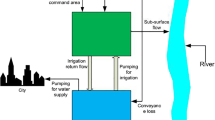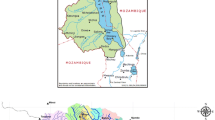Abstract
Sustainable management of groundwater resources is critical for viable development of semi-arid regions. Refugio County, TX, is predominantly a rural community that is in close proximity to two large urban areas of Corpus Christi and San Antonio. Large-scale water supply projects are being planned to export surplus water available in Refugio County to nearby growing cities. Being a coastal county with several sensitive bays and estuaries, these projects have caused concerns with regard to decreases in freshwater inflows to coastal bodies and raised the possibility of saltwater intrusion. A simulation model characterizing groundwater flow in the shallower unconfined and the deeper semi-confined formations of the Gulf coast aquifer was calibrated and evaluated. The model results were used in conjunction with a mathematical programming scheme to estimate maximum available groundwater in the county. Stakeholder concerns were incorporated as constraints, which included prevention of saltwater intrusion in the aquifer, limiting the amount of allowable drawdown in shallow aquifers, as well as maintaining current flow gradients especially near baseflow-dependent streams and rivers. For the conditions assumed in this study, the model results indicate that roughly 4.93 × 107 m3 of water can be extracted in a typical year. The management model was noted to be very sensitive to the imposed saltwater intrusion constraint.








Similar content being viewed by others
References
Ahlfeld DP, Mulligan AE (2001) Optimal management of flow in groundwater systems. Academic, San Diego
Anderson MP, Woessner WW (1992) Applied groundwater modeling: simulation of flow and advective transport. Academic, San Diego
Baker ET (1979) Stratigraphic and hydrogeological framework of part of the coastal plain of Texas. Texas Department of Water Resources, Austin, 43 pp
Beekman HE, Xu YX (2003) Review of groundwater estimation in arid and semi-arid southern Africa. System for Analysis Research and Training, South Africa, 17 pp
Chowdhury AH, Wade S, Mace RE, Ridgeway C (2004) Groundwater availability model of the central gulf coast aquifer system: numerical simulations through 1999. Texas Water Development Board, Austin, 108 pp
Emch PG, Yeh W-G (1998) Management model for conjunctive use of coastal and surface water and groundwater. J Water Resour Plan Manag 124:129–139
ESI (1996) Guide to using groundwater Vistas: advanced model design and analysis. Environmental Simulations Inc., Herndon, 180 pp
Finney BA, Samsuhadi S, Willis R (1992) Quasi-three-dimensional optimization model of Jakarta basin. J Water Resour Plan Manag 118:18–31
GBRA (2005) Lower Guadalupe water supply project. http://www.gbra.org. Accessed September 2005
Harbaugh AW, Banta ER, Hill MC, McDonald MG (2000) MODFLOW-2000, the US Geological Survey modular ground-water model-user guide to modularization concepts and the ground-water flow process. US Geological Survey, 121 pp
Jones IC (2005) Central gulf coast aquifer groundwater availability model run for Refugio county, TX. Texas Water Development Board, Austin, 7 pp
Lindo Systems, Inc., NY (2005) http://www.lindo.com. Accessed July 2004
Mace RE, Mullican WF, Way S-C (2001) Estimating groundwater availability in Texas. In: Proceedings of the 1st annual Texas Rural Water Association and Texas Water Conservation Association Water Law seminar: water allocation in Texas: the legal issues, Austin, TX, 16 pp
Mason C (1963) Water resources of Refugio County, TX. Texas Water Commission, Austin
NWS (2003) National Climatic Data Center. http://www.ncdc.noaa.gov. Accessed July 2003
Pettyjohn WA, Henning R (1979) Preliminary estimate of ground-water recharge rates, related streamflow and water quality in Ohio. Ohio State University Water Resources Center, Ohio, 323 pp
Pinder GF, Celia M, Gray WG (1981) Velocity calculation from randomly located hydraulic heads. Groundwater 19:262–264
Shamir U, Bear J, Gamliel A (1984) Optimal annual operation of a coastal aquifer. Water Resour Res 20:435–444
TWDB (2002) Water for Texas—2002. Texas Water Development Board, Austin, p 141
Waterstone (2002) Groundwater availability of the central gulf coast aquifer: numerical simulations to 2050 central gulf coast, Texas. Waterstone Environmental Hydrology and Engineering, Inc. for Texas Water Development Board, 156 pp
Willis R, Finney BA (1988) Planning model for control of salt water intrusion. J Water Resour Plan Manag 114:333–347
Zhou X, Chen M, Liang C (2003) Optimal schemes of groundwater exploitation for prevention of seawater intrusion in the Leizhou Peninsula in Southern China. Environ Geol 43:978–985
Acknowledgments
This material is based on work supported by NSF under Cooperative Agreement No. HRD-0206259 and other financial and logistic support from Refugio Groundwater Conservation District. Any opinions, findings and conclusions or recommendations expressed in this material are those of the authors and do not necessarily reflect the views of the National Science Foundation or the Refugio Groundwater Conservation District.
Author information
Authors and Affiliations
Corresponding author
Rights and permissions
About this article
Cite this article
Uddameri, V., Kuchanur, M. Simulation-optimization approach to assess groundwater availability in Refugio County, TX. Environ Geol 51, 921–929 (2007). https://doi.org/10.1007/s00254-006-0455-2
Received:
Accepted:
Published:
Issue Date:
DOI: https://doi.org/10.1007/s00254-006-0455-2




